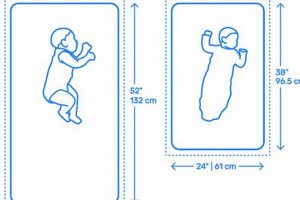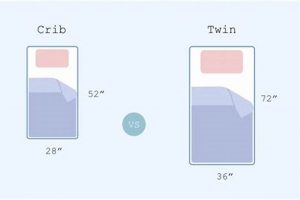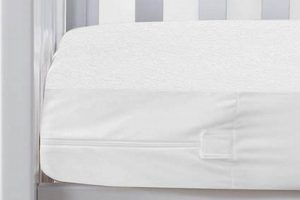The dimensions of infant sleeping surfaces within cribs adhere to specific regulations, ensuring safety and compatibility. These measurements typically encompass a rectangle of approximately 28 inches in width and 52 inches in length. Deviations from these standardized figures are generally not recommended due to potential safety hazards arising from gaps between the sleep surface edge and the crib frame.
Adherence to these regulated measurements provides numerous advantages. It promotes infant safety by mitigating the risk of entrapment, suffocation, or falls. Furthermore, uniformity in dimensions simplifies the purchasing process for parents, allowing for easy acquisition of fitted sheets and other bedding accessories designed to conform to these established measurements. Historically, these standardizations have evolved in response to safety concerns and advancements in crib design, reflecting ongoing efforts to optimize infant well-being during sleep.
Subsequent sections will delve into the various materials used in constructing these sleeping surfaces, discuss considerations for selecting an appropriate one based on infant needs, and address the importance of maintaining a clean and hygienic sleep environment.
Important Considerations Regarding Crib Mattress Dimensions
Selecting the appropriate infant sleeping surface requires careful attention to detail. Conformity to regulated measurements is paramount for safety and optimal functionality.
Tip 1: Verify Dimensions: Prior to purchase, meticulously measure the interior of the crib frame to ensure compatibility with standardized sleeping surfaces. Discrepancies can lead to hazardous gaps.
Tip 2: Consult Certifications: Look for certifications from reputable organizations that validate adherence to safety and performance standards. These certifications provide assurance of product quality and conformity.
Tip 3: Inspect Edge Support: Examine the firmness of the mattress edges. Adequate edge support prevents sagging and reduces the risk of entrapment if the infant rolls against the side of the crib.
Tip 4: Choose the Correct Sheet Size: Always use fitted sheets designed specifically for standardized sleeping surfaces. Loose or ill-fitting sheets can pose a suffocation hazard.
Tip 5: Regularly Inspect for Wear: Periodically examine the sleeping surface for signs of wear and tear, such as tears, indentations, or compromised seams. Replace the mattress if any damage is detected.
Tip 6: Maintain Cleanliness: Regularly clean the sleeping surface according to the manufacturer’s instructions to prevent the build-up of bacteria and allergens. A clean environment promotes infant health and well-being.
Adhering to these guidelines ensures a secure and comfortable sleep environment for the infant. Selecting a sleeping surface that conforms to standardized measurements is a crucial step in safeguarding infant health.
The subsequent section will address specific material considerations when choosing a crib mattress.
1. Width
The dimension of 28 inches for the width of an infant sleeping surface is a critical component defining its standardized form. This measurement, while seemingly simple, has profound implications for safety, functionality, and overall design.
- Safety Compliance
The 28-inch width is not arbitrary; it is derived from safety regulations designed to minimize hazards. A narrower width could compromise sleep space, while a wider dimension might create gaps between the mattress and crib frame, posing entrapment risks. Compliance with this standard ensures the infant is safely contained within the crib.
- Compatibility with Crib Structures
The vast majority of cribs manufactured adhere to internal dimensions that accommodate a 28-inch wide sleeping surface. This ensures that the mattress fits snugly within the frame, preventing movement and eliminating potential pinch points. Deviation from this width could render a mattress incompatible with standard crib models.
- Optimized Comfort and Movement
While prioritizing safety, the 28-inch width also allows sufficient space for the infant to move and reposition comfortably during sleep. This dimension is a balance between providing a secure environment and allowing for natural movement patterns. A more confined space could restrict movement, potentially leading to discomfort.
- Facilitating Bedding Standardization
A consistent 28-inch width simplifies the production and purchase of fitted sheets and other bedding accessories. Manufacturers can reliably produce bedding that fits correctly, and parents can confidently select items knowing they will be compatible with the mattress. This standardization reduces confusion and ensures proper fit, preventing loose bedding from becoming a hazard.
In summary, the 28-inch width is an indispensable aspect of the standardized infant sleeping surface. It is not merely a measurement but a crucial element that underpins safety regulations, facilitates compatibility with crib structures, promotes comfort, and streamlines the bedding industry. Adherence to this dimension is paramount for creating a secure and functional sleep environment for infants.
2. Length
The 52-inch length dimension of a standard infant sleeping surface is an integral component of its overall design, directly influencing safety parameters and compatibility within crib enclosures.
- Mandatory Adherence to Safety Regulations
The 52-inch length is not discretionary; it is a stipulated parameter within safety standards established by regulatory bodies. This specific dimension mitigates potential hazards, such as gaps between the sleeping surface and the crib’s headboard or footboard. Failure to adhere to this length introduces the risk of infant entrapment, necessitating strict compliance.
- Ensuring a Safe and Secure Sleeping Environment
A 52-inch length is deliberately designed to provide sufficient space for an infant to comfortably reposition and move within the crib without compromising safety. This dimension allows for unrestricted movement while concurrently minimizing the risk of contact with crib railings. A shorter dimension might restrict movement, while a longer dimension creates hazardous gaps.
- Optimizing Crib Frame Design and Manufacturing
The 52-inch length dimension directly informs the design and manufacturing specifications of standard crib frames. Crib manufacturers engineer their products to precisely accommodate a sleeping surface of this length, ensuring a snug and secure fit. This alignment between mattress and crib dimensions is fundamental to maintaining a safe sleep environment.
- Streamlining Bedding Product Development
The standardized length of 52 inches facilitates the development and production of properly fitting crib bedding. Fitted sheets, mattress protectors, and other accessories are designed and manufactured based on this established dimension. This standardization ensures that bedding products fit securely on the mattress, reducing the risk of loose or ill-fitting items that could pose a suffocation hazard.
Collectively, these facets underscore the critical role of the 52-inch length dimension in ensuring infant safety and compatibility within standard crib configurations. Deviations from this standardized measurement introduce potential hazards and compromise the integrity of the intended sleep environment. Adherence to this length is thus an indispensable element of safe crib design and usage.
3. Thickness Variability
Thickness variability within the defined parameters of infant sleeping surfaces represents a nuanced aspect of the “standard size of crib mattress.” While width and length are rigidly controlled to ensure compatibility with crib frames and mitigate entrapment risks, thickness exhibits a permissible range. This variability stems from differences in internal construction, material densities, and the presence or absence of features such as integrated support layers. For instance, a basic innerspring sleeping surface might have a different thickness compared to a multi-layered foam model incorporating memory foam or a convoluted comfort layer. The importance of this variability lies in its impact on comfort, support, and the overall safety of the sleep environment. Excessive thickness could reduce the height of the crib rail, potentially allowing a child to climb out. Conversely, inadequate thickness might compromise support and pressure distribution, possibly affecting infant comfort and spinal alignment.
Real-world examples demonstrate the practical implications of understanding thickness variability. A parent unknowingly purchasing an exceptionally thick sleeping surface might inadvertently reduce the effective crib rail height below regulated safety thresholds, creating a climb-out hazard. Alternatively, selecting a sleeping surface that is too thin might fail to provide adequate support, particularly for infants with specific musculoskeletal needs. Furthermore, variations in thickness can affect the fit of fitted sheets. A sheet designed for a standard thickness might be excessively tight or loose on a sleeping surface with atypical dimensions. Properly acknowledging this variability is critical to balance the benefits of enhanced comfort or material composition with the need to uphold established safety protocols.
In summary, while the width and length dimensions of infant sleeping surfaces are strictly standardized, thickness variability introduces a degree of complexity. It necessitates careful consideration of the specific sleeping surface’s characteristics and their interaction with the crib frame, bedding, and the infant’s developmental stage. Challenges arise in educating consumers about these subtle distinctions and promoting a comprehensive understanding of how thickness affects overall safety and suitability. Therefore, selecting an infant sleeping surface involves more than simply adhering to the specified width and length; it requires evaluating the potential ramifications of thickness deviations within the broader context of safe sleep practices.
4. Corner Radius
The corner radius of a standard-sized crib mattress, while seemingly a minor detail, is a deliberate design element that contributes to safety and fit within the crib structure. The purpose of specifying a corner radius, as opposed to sharp, 90-degree corners, is multifaceted. A rounded corner reduces the likelihood of snags or tears in crib sheets and bedding, thereby minimizing potential hazards. Furthermore, a defined corner radius assists in the proper seating of the sleeping surface within the crib frame, preventing the corners from catching on the interior structure and ensuring a flush, secure fit. Failure to adhere to a compatible corner radius can result in gaps between the sleeping surface and the crib sides, increasing the risk of entrapment. Consider a scenario where a sleeping surface with sharp corners is forced into a crib designed for rounded corners; this creates stress points and potential vulnerabilities in the crib structure itself, in addition to compromising the safety of the sleep environment.
The specific dimensions of the corner radius are typically dictated by industry standards and crib design specifications. Manufacturers design cribs with a predetermined corner curvature to accept sleeping surfaces with a matching radius. This compatibility is essential for preventing movement or shifting of the mattress within the frame, thereby preserving the integrity of the intended safety features. The practical application of this understanding is evident during the purchase of a replacement mattress. If the replacement’s corner radius deviates significantly from the original design, it may not seat correctly, resulting in instability and potential gaps. Inspection of the corner radius before purchase is therefore a crucial step in ensuring a safe and compatible fit.
In summary, the corner radius is not merely an aesthetic consideration; it is an integral component of the “standard size of crib mattress,” directly influencing its fit, stability, and overall safety. The challenge lies in communicating the importance of this seemingly minor detail to consumers, who often focus primarily on width, length, and thickness. Understanding the role of the corner radius is vital for selecting a safe and appropriate infant sleeping surface.
5. Edge Firmness
Edge firmness constitutes a critical, yet often overlooked, characteristic inextricably linked to the established parameters for infant sleeping surfaces. While the overall dimensions determine the compatibility of the sleeping surface with the crib structure, edge firmness directly impacts safety by influencing the likelihood of infant entrapment between the mattress edge and the crib railing. Insufficient edge support can lead to sagging or compression near the perimeter, creating a hazardous gap. This issue is particularly relevant as infants begin to explore their surroundings and push themselves against the sides of the crib. A sleeping surface lacking adequate edge firmness compromises the integrity of the safe sleep environment, increasing the potential for injury.
The practical significance of edge firmness is evident in scenarios involving infant movement near the crib perimeter. Consider a situation where an infant rolls towards the edge of the mattress. A firm edge provides resistance, preventing the infant from becoming wedged between the mattress and the crib railing. Conversely, a soft or yielding edge allows the infant to sink into the gap, potentially restricting breathing or causing injury. Furthermore, strong edge support facilitates the transition to standing and walking, as infants often utilize the crib sides for support. Adequate edge firmness ensures stability and reduces the risk of falls during this developmental phase. Regulations mandate specific levels of firmness to mitigate these risks, and manufacturers must adhere to these standards to ensure product safety.
In conclusion, edge firmness is an indispensable component of a safe infant sleeping surface, intricately connected to its overall dimensions. While the length and width ensure proper fit, the firmness of the edges directly addresses the potential for entrapment and supports infant development. The challenge lies in effectively communicating the importance of edge firmness to caregivers, who often prioritize other features such as comfort or material composition. Emphasizing the safety implications and providing clear guidelines for assessing edge support are crucial steps in promoting a safer sleep environment for infants.
6. Sheet Compatibility
Sheet compatibility is inextricably linked to the established dimensions of infant sleeping surfaces. Adherence to these standardized measurements ensures that fitted sheets and other bedding accessories fit securely and safely, minimizing potential hazards within the crib environment.
- Dimensional Accuracy and Safety
The primary role of dimensional accuracy is to guarantee that a fitted sheet precisely conforms to the sleeping surface’s perimeter. A sheet that is too large presents a risk of bunching or becoming loose, potentially leading to suffocation or entanglement. Conversely, a sheet that is too small may strain or tear, compromising its integrity and diminishing its protective function. Adherence to the established width and length of the sleeping surface is therefore paramount for maintaining a safe sleep environment.
- Fabric Elasticity and Fit
Fabric elasticity plays a crucial role in sheet compatibility. Materials with insufficient elasticity may not adequately grip the sleeping surface, resulting in slippage and potential displacement. This compromise in fit negates the intended safety features, as loose fabric can pose an entanglement risk. Conversely, excessively elastic materials can distort the shape of the sleeping surface or place undue stress on the seams, ultimately shortening the lifespan of the sheet.
- Corner Depth and Secure Attachment
The corner depth, or the distance from the corner seam to the elasticized edge, directly impacts the sheet’s ability to securely grip the sleeping surface. Insufficient corner depth can lead to the sheet dislodging from the corners, creating potential hazards. Conversely, excessive corner depth can result in bunching or wrinkling, diminishing the sheet’s protective function and creating potential discomfort for the infant. A well-designed corner depth ensures a snug and secure attachment, minimizing the risk of displacement.
- Material Breathability and Airflow
Material breathability, though not directly related to fit, is an essential aspect of sheet compatibility. A sheet constructed from non-breathable materials can impede airflow, increasing the risk of overheating and discomfort for the infant. Conversely, breathable materials promote air circulation, maintaining a comfortable sleep environment and reducing the potential for skin irritation. Selecting sheets made from breathable fabrics is therefore critical for ensuring both safety and comfort.
These facets underscore the critical role of sheet compatibility in maintaining a safe and functional sleep environment for infants. Proper adherence to the established dimensions of infant sleeping surfaces, coupled with careful consideration of fabric elasticity, corner depth, and material breathability, is essential for minimizing potential hazards and promoting infant well-being.
Frequently Asked Questions
The following addresses commonly raised inquiries regarding the established measurements for infant sleeping surfaces, providing clarity on their significance and implications for safety and compatibility.
Question 1: What are the precise dimensions designated as “standard” for infant sleeping surfaces within cribs?
The accepted norm specifies a rectangular shape approximately 28 inches in width and 52 inches in length. Variations beyond these dimensions are generally discouraged due to potential safety concerns.
Question 2: Why is adherence to these dimensions crucial?
Adherence to these dimensions mitigates the risk of gaps between the mattress and the crib frame, preventing potential entrapment or suffocation hazards. It also facilitates the acquisition of properly fitting sheets and bedding accessories.
Question 3: What happens if a sleeping surface deviates from these dimensions?
Deviations can lead to instability within the crib, creating gaps that pose safety risks. Ill-fitting sheets can also become a hazard. Selecting a sleeping surface that strictly adheres to these measurements is thus paramount.
Question 4: Are there variations in thickness permitted within the standard dimensions?
While width and length are rigidly controlled, thickness can exhibit some variation. However, excessively thick sleeping surfaces may reduce the effective crib rail height, potentially creating a climb-out hazard. Conversely, inadequate thickness may compromise support.
Question 5: How does corner radius factor into overall safety and compatibility?
The specified corner radius is a designed element that reduces the likelihood of snags or tears in crib sheets. It assists in the proper seating of the sleeping surface within the crib, ensuring a secure fit and preventing potential gaps.
Question 6: What role does edge firmness play in ensuring infant safety?
Edge firmness prevents sagging or compression near the perimeter, minimizing the risk of entrapment between the mattress edge and the crib railing. Strong edge support also facilitates the transition to standing and walking.
These considerations highlight the importance of a comprehensive understanding of infant sleeping surface dimensions, ensuring the selection of a safe and compatible product.
The subsequent section will provide guidance on choosing the appropriate material for an infant sleeping surface.
Standard Size of Crib Mattress
This exploration of the established dimensions for infant sleeping surfaces has underscored the significance of adhering to these standards for ensuring infant safety and well-being. From the mandated width and length to the subtle considerations of thickness, corner radius, and edge firmness, each element plays a crucial role in creating a secure sleep environment. The discussion has revealed that these seemingly simple measurements are, in fact, critical parameters that directly impact a child’s health and safety within the confines of a crib.
Therefore, diligent attention must be paid to these dimensions when selecting an infant sleeping surface. Informed decisions based on a comprehensive understanding of these established parameters are paramount. Prioritizing adherence to the “standard size of crib mattress” is not merely a recommendation but an essential measure in safeguarding the life and health of an infant.


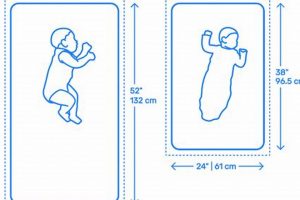
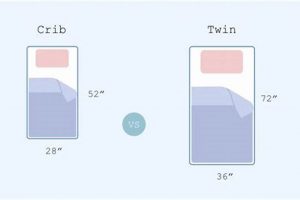
![Choosing the Right Short Crib Mattress [Guide] Organic & Natural Mattress Buyer’s Guide: Non-Toxic Sleep Solutions Choosing the Right Short Crib Mattress [Guide] | Organic & Natural Mattress Buyer’s Guide: Non-Toxic Sleep Solutions](https://mattressworldpa.com/wp-content/uploads/2025/07/th-1280-300x200.jpg)
